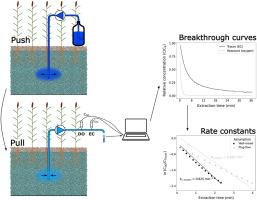Development of single well push–pull tests for measuring local rate constants in horizontal subsurface flow constructed wetlands
IF 13.3
1区 工程技术
Q1 ENGINEERING, CHEMICAL
引用次数: 0
Abstract
The single well push–pull test (SWPPT) involves injecting a solution into a well and later extracting it to assess reaction rates by analyzing changes in concentration over time. This study first optimized the conditions for conducting SWPPTs in a horizontal subsurface flow constructed wetland (HSSFCW) and then determined in situ heterotrophic aerobic and anoxic reaction rates in the influent zone of the HSSFCW. The optimal tracer concentration and injection solution volume for the SWPPT were determined to be 0.3 g NaCl L-1 and 10 L, respectively. Rate constants were derived using two different models: well-mixed and plug-flow. The average well-mixed and plug-flow first-order oxygen rate constants were 0.95 ± 0.20 and 0.66 ± 0.14 min−1, respectively. After adding an easily degradable carbon source to the aerated injection solution, the heterotrophic yield coefficient was calculated to be 0.50 gCOD gCOD-1. First-order denitrification rate constants varied across the HSSFCW influent zone, ranging between 0.005–0.035 min−1 for the well-mixed model and 0.004–0.027 min−1 for the plug-flow model. The heterotrophic denitrification yield coefficient YdH values averaged at 0.55 ± 0.33. Different oxygen utilization routes were identified, with the bulk consumed in multiple biological processes, a small portion lost to trapped gas bubbles and an insignificant amount to chemical reactions. The results of this study demonstrate the potential of using SWPPTs to measure heterotrophic aerobic and denitrifying degradation rate constants and yield in situ in HSSFCWs.

求助全文
约1分钟内获得全文
求助全文
来源期刊

Chemical Engineering Journal
工程技术-工程:化工
CiteScore
21.70
自引率
9.30%
发文量
6781
审稿时长
2.4 months
期刊介绍:
The Chemical Engineering Journal is an international research journal that invites contributions of original and novel fundamental research. It aims to provide an international platform for presenting original fundamental research, interpretative reviews, and discussions on new developments in chemical engineering. The journal welcomes papers that describe novel theory and its practical application, as well as those that demonstrate the transfer of techniques from other disciplines. It also welcomes reports on carefully conducted experimental work that is soundly interpreted. The main focus of the journal is on original and rigorous research results that have broad significance. The Catalysis section within the Chemical Engineering Journal focuses specifically on Experimental and Theoretical studies in the fields of heterogeneous catalysis, molecular catalysis, and biocatalysis. These studies have industrial impact on various sectors such as chemicals, energy, materials, foods, healthcare, and environmental protection.
 求助内容:
求助内容: 应助结果提醒方式:
应助结果提醒方式:


